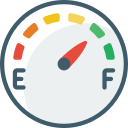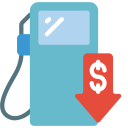Revolutionize Your Fleet Management with Sahaj VTS Pro’s Fuel Based Vehicle Tracking
Comprehensive Vehicle Tracking with Advanced Fuel Management

Fuel Monitoring
Sahaj VTS Pro offers a robust Vehicle Tracking System integrated with advanced fuel management capabilities. Our software supports multiple fuel sensors, providing real-time fuel level monitoring, drain alerts, fill events, and comprehensive fuel consumption data. This integration ensures that fleet managers have complete visibility over their vehicles’ fuel usage, enabling efficient management and cost savings.
Key Features

Real-Time Fuel Level Monitoring
Our system continuously tracks fuel levels, providing instant alerts for any significant changes, such as fuel drains or fills. This helps in preventing fuel theft and ensuring timely refueling.

Drain and Fill Alerts
Receive immediate notifications for any fuel drain or fill events. This feature is crucial for detecting unauthorized fuel usage and maintaining accurate fuel records

Fuel Consumption Tracking
Monitor fuel consumption in real-time, allowing for precise tracking of fuel usage across different trips and vehicles. This data is essential for optimizing fuel efficiency and reducing operational costs.

Theft Detection
Our advanced algorithms detect unusual fuel consumption patterns, alerting you to potential fuel theft. This proactive approach helps in safeguarding your fuel assets.
Detailed Reports

Fill/Drain Reports
Comprehensive logs of all fuel fill and drain events, providing insights into fuel usage patterns and helping in identifying discrepancies.

Consumption Reports
Detailed analysis of fuel consumption over time, enabling better fuel budgeting and planning.

Tripwise Fuel Consumption Reports
Breakdown of fuel usage for each trip, helping in assessing the fuel efficiency of different routes and driving behaviors.
Specialized Reports

Fuel Economy Report
Analyze the fuel efficiency of your fleet by comparing fuel consumption against distance traveled. This report helps in identifying vehicles with poor fuel economy and taking corrective actions

Fuel Trip Cost Report
Calculate the cost of fuel for each trip, providing a clear picture of fuel expenses associated with specific routes and deliveries. This report is essential for accurate cost accounting and route optimization.

Work Hour vs. Fuel Mileage Report
Compare the fuel mileage against the work hours of your vehicles. This report helps in understanding the relationship between vehicle usage and fuel efficiency, aiding in better fleet management.

AC Fuel Usage Summary
Track the fuel consumption attributed to air conditioning usage. This report helps in identifying the impact of AC usage on overall fuel efficiency and managing it effectively

Fuel Expense Summary Report
Summarize all fuel-related expenses, providing a clear overview of fuel costs across your fleet. This report is crucial for budgeting and financial planning.
By leveraging Sahaj VTS Pro, you can achieve unparalleled control over your fleet’s fuel management, ensuring optimal fuel usage, reducing costs, and enhancing overall operational efficiency. Our comprehensive reporting tools provide the insights needed to make informed decisions and drive your fleet’s performance to new heights.
Scope of Fuel Base Vehicle Tracking System
Agriculture Industry
Challenges
- Lack of fuel data leads to unexpected fuel shortage.
- Fuel theft is a major concern, dificult to detect.
- Vehicle idling, leads to unnecessary fuel consumption.
Solutions
- Install sensors in the fuel tank of tractors and harvesters.
- Get alerts and detailed fuel reports to detect fuel theft.
- Utilize data analytics to track fuel consumption patterns.

Construction Industry
Challenges
- Construction sites are prone to fuel theft.
- Equipment downtime due to running out of fuel.
- Dificulty in manually monitoring fuel levels and
consumption paerns.
Solutions
- Sensors provide real-time data on the fuel levels.
- Instant alerts for low fuel levels or sudden decreases.
- Use data to identify trends, and optimize fuel usage.

Mining Industry
Challenges
- Monitoring fuel levels in remote mining sites is challenging.
- Mining companies struggle to detect fuel theft or
unauthorized usage. - Production disruptions due to unexpected fuel shortages.
Solutions
- Fuel sensors provides accurate data on fuel levels remotely.
- Automated alerts notify of fuel theft or anomalies.
- Real-time fuel monitoring and consumption paerns to
prevent fuel shortages.

Transportation and Logistics
Challenges
- Manual fuel monitoring is prone to error.
- Ignoring low fuel levels can cause damage to engines or lead to unexpected breakdowns.
- Detecting fuel theft is challenging.
Solutions
- Real-time data on fuel levels, eliminates the need for manual checks.
- Alerts for low fuel levels to prevent unplanned downtime.
- Detection of fuel theft provided through alerts & reports.

Stationary Fuel Tanks
Challenges
- Traditional methods rely on manual inspections.
- Manual readings may result in differences in fuel inventory
records. - Water or sediment buildup can contaminate tanks
compromising fuel quality.
Solutions
- Real-time data on fuel levels, for automated inventory tracking.
- Sensors give accurate fuel data.
- Sensors spot fuel abnormalities like water or sediment.

Gensets
Challenges
- Inaccurate readings can lead to unexpected shutdowns.
- Absence of real-time data affects refueling schedules.
- Unplanned downtime and higher maintenance expenses.
Solutions
- Install fuel level sensors in gen sets for accurate monitoring
- Utilize real-time data for visibility into fuel levels for better planning.
- Configure alerts to notify when fuel level hits set
thresholds,for timely refueling.

Agriculture Industry
Challenges
- Lack of fuel data leads to unexpected fuel shortage.
- Fuel theft is a major concern, dificult to detect.
- Vehicle idling, leads to unnecessary fuel consumption.
Solutions
- Install sensors in the fuel tank of tractors and harvesters.
- Get alerts and detailed fuel reports to detect fuel theft.
- Utilize data analytics to track fuel consumption patterns.

Construction Industry
Challenges
- Construction sites are prone to fuel theft.
- Equipment downtime due to running out of fuel.
- Dificulty in manually monitoring fuel levels and
consumption paerns.
Solutions
- Sensors provide real-time data on the fuel levels.
- Instant alerts for low fuel levels or sudden decreases.
- Use data to identify trends, and optimize fuel usage.

Mining Industry
Challenges
- Monitoring fuel levels in remote mining sites is challenging.
- Mining companies struggle to detect fuel theft or
unauthorized usage. - Production disruptions due to unexpected fuel shortages.
Solutions
- Fuel sensors provides accurate data on fuel levels remotely.
- Automated alerts notify of fuel theft or anomalies.
- Real-time fuel monitoring and consumption paerns to
prevent fuel shortages.

Transportation and Logistics
Challenges
- Manual fuel monitoring is prone to error.
- Ignoring low fuel levels can cause damage to engines or lead to unexpected breakdowns.
- Detecting fuel theft is challenging.
Solutions
- Real-time data on fuel levels, eliminates the need for manual checks.
- Alerts for low fuel levels to prevent unplanned downtime.
- Detection of fuel theft provided through alerts & reports.

Stationary Fuel Tanks
Challenges
- Traditional methods rely on manual inspections.
- Manual readings may result in differences in fuel inventory
records. - Water or sediment buildup can contaminate tanks
compromising fuel quality.
Solutions
- Real-time data on fuel levels, for automated inventory tracking.
- Sensors give accurate fuel data.
- Sensors spot fuel abnormalities like water or sediment.

Gensets
Challenges
- Inaccurate readings can lead to unexpected shutdowns.
- Absence of real-time data affects refueling schedules.
- Unplanned downtime and higher maintenance expenses.
Solutions
- Install fuel level sensors in gen sets for accurate monitoring
- Utilize real-time data for visibility into fuel levels for better planning.
- Configure alerts to notify when fuel level hits set
thresholds,for timely refueling.

Industries
Link

Construction
Link

Ambulances & Healthcare Industries
Link

FMCG
Link

GPCB & Mining
Link

Transport and Logistics
